Daniel Martinez Calonge
Advanced laboratory testing of offshore wind turbine foundations under lateral loading
Started: October 2014
Supervisor: Zdravkovic, L.; Sim, W.W.
Funding: EPSRC, GCG
Background
In recent years, the study of the thermo-hydro-mechanical (THM) behaviour of soils has been a growing area of research within the geotechnical community, due to its importance in a wide range of contemporary civil engineering applications and activities. One strand of the THM research has primarily focused on the potential use of clays as a barrier material in nuclear waste disposal facilities. Stiff clays and argillites have been considered as potential host rocks for the long-term nuclear waste disposal at great depth (Gens et al., 2007). As part of the multi-barrier concept, heavily compacted swelling clays such as the MX-80 bentonite have been considered for the use as engineered barriers (Delage et al., 2010). Another strand of the THM research has been made in the area of ground heat storage and its effects on the host soil (Moritz, 1995). Several applications of varying scales, such as underground storage tanks or systems of buried pipes to which heat is injected, have been developed in recent years. Currently, there is a growing interest in incorporating pipe loops for groundsource heat-pump systems to piled foundations (Bourne-Webb et al., 2009). Other energy applications that involve high temperatures in the ground are buried high-voltage cables (Mitchell et al., 1982) and thermal techniques of enhanced oil recovery such as fireflooding (Dusseault et al., 1988).
These complex problems require the understanding of the thermal behaviour of the ground and also of the effects of temperature on its hydraulic and mechanical behaviour which conventional soil mechanics knowledge does not explain. The aim of this research project is to gain this understanding throughout the experimental characterisation of thermo-hydro-mechanical behaviour of clays. The project firstly focuses on the development of new experimental capabilities at the Imperial College Soil Mechanics Laboratory, including temperature-controlled triaxial apparatuses like the one shown in Figure 1 and cells capable of measuring the thermal and hydraulic properties of soils. Secondly, a complete testing programme will allow the characterisation of the THM behaviour of reconstituted London clay, presenting useful information for the design of geothermal structures in the London area. Finally, a novel system of relative humidity control will be implemented to the equipment, allowing for testing the samples of the MX-80 bentonite under high-suction conditions and simulating the high thermo-hydro-mechanical loads that would be applied in an underground nuclear waste storage facility.

References
- Bourne-Webb, P. J., Amatya, B., Soga, K., Amis, T., Davidson, C. & Payne, P. (2009) Energy pile test at Lambeth College, London: geotechnical and thermodynamic aspects of pile response to heat cycles. Geotechnique. 59 (3), 237-248.,
- Delage, P., Cui, Y. J. & Tang, A. M. (2010) Clays in radioactive waste disposal. Journal of Rock Mechanics and Geotechnical Engineering. 2 (2), 111-123.
- Dusseault, M. B., Wang, Y. & Simmons, J. V. (1988) Induced stresses near a fire flood front. AOSTRa J. Res. 4, 153-170.
- Gens, A., Vaunat, J., Garitte, B. & Wileveau, Y. (2007) In situ behaviour of a stiff layered clay subject to thermal loading: observations and interpretation. Géotechnique, 57 (2), 207-228
- Martinez Calonge, D. (2013) Development of new high temperature triaxial apparatus. MSc Thesis. Imperial College, London, UK.
- Mitchell, J. K., McMillan, J. C., Green, S. L. & Sisson, R. C. (1982) Field testing of cable backfill systems. In: Underground Cable Thermal Backfill. New York, Pergamon Press. pp. 19-33.
- Moritz, L. (1995) Geotechnical properties of clay at elevated temperatures. Swedish Geotechnical Institute. Report number: 47.
DANIEL MARTINEZ COLONGE
 PhD Candidate - Geotechnics
PhD Candidate - Geotechnics
Department of Civil & Environmental Engineering
Imperial College London SW7 2AZ
daniel.martinez-calonge12@imperial.ac.uk


